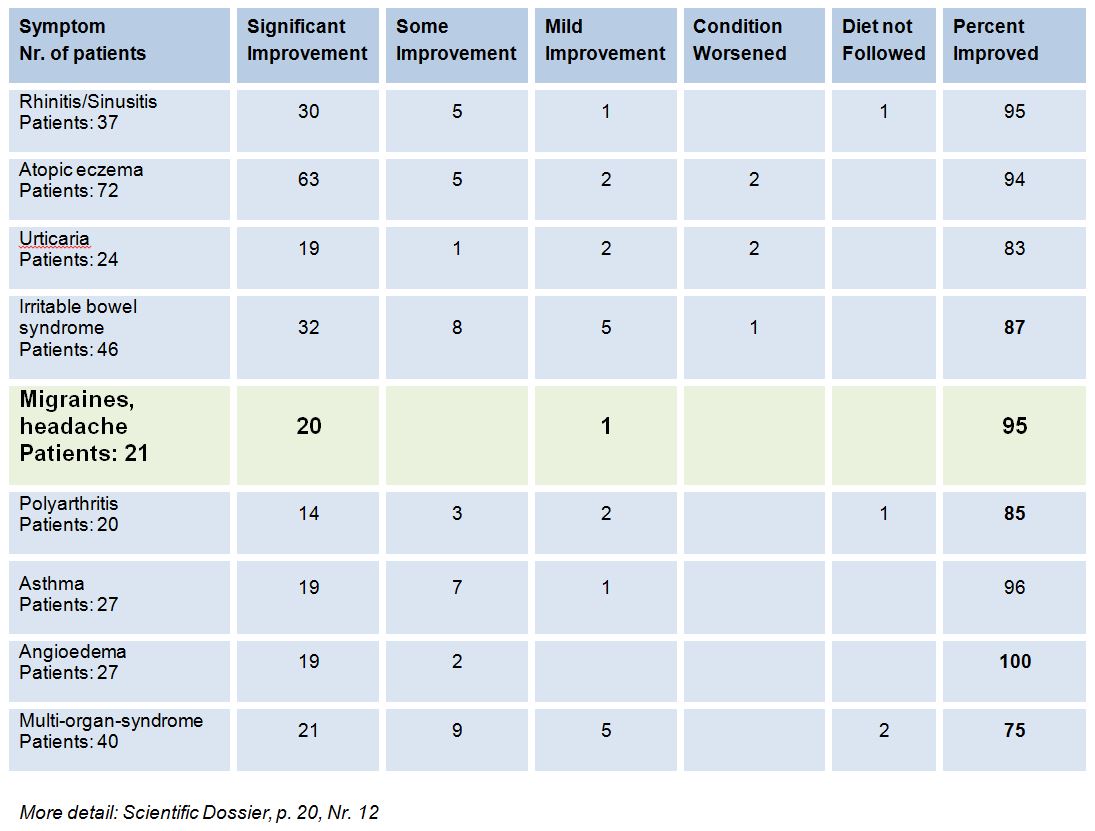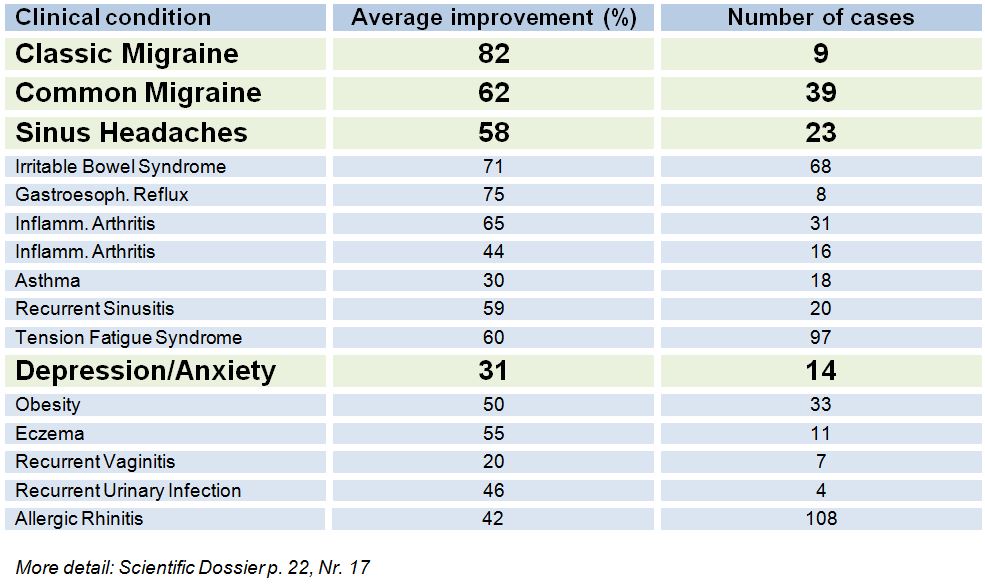Migraine and Headache
Pauline Harding, MD, Family Medicine Practitioner
One middle-aged woman with chronic headaches discovered that the aspartame in her toothpaste was the culprit.
Headaches are global disabling conditions. In children and adolescents, headache has a suggested overall mean prevalence of 54.4% (95% CI 43.1-65.8) and migraine, 9.1% (95% CI 7.1-11.1)1. These painful conditions, which include migraine, cluster, or tension headache, can occur in any part of the head.
Migraine is a neurological disorder with painful, sometimes disabling headaches. Often accompanied by gastrointestinal complaints, e.g. IBS, celiac disease, nausea and/or vomiting and sensitivity to light, noise, or smell2, these throbbing headaches usually occur on only one side of the head, although the pain can shift from one side of the head to the other or occur on both sides at the same time. Migraines involve changes in chemicals and blood vessels in the brain, which trigger pain signals leading to headache and other symptoms.
Triggers include certain foods, medications, stress, lack of sleep, or even atmospheric changes 3. Eliminating exposure to these triggers may stop the headaches. A migraine headache typically lasts 4 to 24 hours but in some cases can last up to 3 days. Some people have visual disturbances, called a migraine aura, that occur before a headache starts. Migraine sufferers can have several headaches per month, or may go a year or more between incidences.
The Alcat Test Food-Scan can provide the ideal nutritional guidance to avoid cellular defense reactions by avoiding foods that may be triggering migraine or headache.
Hyperactivity / Attention Deficit Disorder (ADD) / Attention Deficit Hyperactivity Disorder (ADHD) / Concentration and Mental Strength
Mark L. Andrews, MD
Another coworker’s testing was done after he started failing college classes and was dealing with untenable ADHA. He was getting ready to start Aderal. For one week after his diet adjustment, he felt like he had the flu. Then his symptoms all cleared and his mentation returned to normal. His grades returned to “A’s” and he never needed the Aderal. This was again, a savings of many thousands of dollars to his insurance company over a lifetime.
The ability to concentrate is the deliberate focus of mental forces on a single activity or goal. In this context, it is known that children who exhibit hyperactivity are often highly reactive to chemical substances (preservatives, dyes) and sugar in the diet 4.
ADHD is a behavioral condition in which individuals have difficulty focusing on tasks. This common disorder begins in early childhood and can continue into adulthood. If not recognized and treated, it can cause problems at home, school, and work and with relationships. Adults with ADHD may find it hard to focus, organize, and finish tasks. They are often forgetful and absent-minded.
Certain foods are thought to have an influence on ADD/ADHD5, with the most common being milk, wheat and sugars. These dietary elements are believed to cause or at least contribute to ADD/ADHD symptoms. Another study showed that celiac disease is often associated with patients exhibiting ADHD 6.
The Gut Health Protocol (GHP) can provide valuable insight in these patients, who may have gastrointestinal conditions such as Celiac disease, non-celiac gluten intolerance, Crohn’s disease, or IBS promoting ADHD6. LINK to GHP info
Eliminating potentially pro-inflammatory foods as identified with the Alcat Test can have a profound impact on ADHD symptoms.
Autism
David Blyweiss, MD
One patient, an 11 year old boy with autism also suffered from a body rash that never went away…it went away after a week of following the diet guidelines.
03/01/2013
Our daughter has been taking Ritalin and Paxil for over 5 years to deal with hyperactivity/ADHD as well as other health, concentration and academic issues.
The alcat test identified numerous foods that we needed to eliminate-such as beef, lemon, grapes and apples. Once we eliminated these foods, we saw a dramatic change with our daughter. Within 24 hours she was much more calm. We slowly weened her off Paxil and Ritalin, and now she is TOTALLY off of these drugs for more than 2 months. The new diet has done wonders.
Dan from Michigan
Autism is a collection of behavioral symptoms characterized by dysfunction in social interaction and communication in affected children 7. It is typically associated with restrictive, repetitive, and stereotypic behavior and manifests within the first 3 years of life. Self-injury and mental retardation may be seen as well. Autism is one form of a group of disorders known as autism spectrum disorders (ASD) 7, 8. ASD includes pervasive developmental disorder and Asperger syndrome. The conditions differ with regard to communication and cognitive development, with many of the forms of ASD overlapping.
The precise causes of these disorders are not known but experts have hypothesized the contributing factors to be influenced by genetics and environment 7. Initial symptoms of autism can be psychological, gastrointestinal or metabolic conditions 7, 9.
The digestive system is linked with the central nervous system, immune function and detoxification. Therefore, most practitioners specializing in ASD first start to help patients by improving GI function. This will most often include the identification of food and chemical sensitivities, the delayed immune response to which can promote intestinal abnormalities.
Parents of children with ASD are familiar with gluten and casein free diets frequently suggested as a strategy they may try. Practitioners point out that these seem to be the most common culprits and once removed from the diet, improvement in digestion as well as behavior is observed in many, but not all patients with ASD. Other food “culprits” need to be identified through testing to eliminate the trial and error guesswork often associated with elimination diets.
Jyonouchi et al. showed that ASD children with gastrointestinal complaints might have a dysregulated innate immune defense which could have an influence on behavioral changes 9. Identifying innate immune system triggering foods may help to support ASD patients.
Chronic Fatigue
03/01/2013
I just wanted to let you know my experience so far with the ALCAT results that I received several weeks ago.
I have suffered with fibromyalgia, extreme fatigue, migraines and a host of odd neurological symptoms for the past two and a half years. I was forced to take a 7 month medical leave of absence from work.
I became deeply depressed and hopeless. I had bloodwork done, MRIs, CAT scans, neurology appointments etc etc etc. Everything came back normal. I was told things were all in my head. I was depressed and miserable. Having the Alcat test was the best decision I have ever made. I have followed the dietary recommendations 100 percent for the last two weeks. I eliminated my reactive foods. During that time I have had only one migraine. Other than that one time I have had no migraines, no fibromyalgia pain, no neurological symptoms and have lost 4 pounds since I began following the dietary recommendations. I feel like a new person. My sleep is deeper and I wake up feeling rested. I cant tell you how happy and amazed I am. Thank you for the work you all do. It has changed my life in just 2 weeks.
Jennifer from Maine
Chronic fatigue syndrome (CFS) causes such profound lethargy that those affected can’t perform the normal, daily activities they once did. There are other symptoms as well, but fatigue lasting 6 months or more is the main one 10. Some people battle CFS for years. The prevalence for CFS varies from 0.2 to approximately 2% 11. Researchers do not know what causes CFS, but they believe this illness involves interactions between a dysfunction of the immune system and trigger agents such as viruses 11. CFS causes fatigue, pain, neurological problems and other symptoms that can be confused with disorders such as severe depression. Each person living with CFS has a unique set of symptoms with a recognizable pattern.
Allergic reactions to food, food intolerance (hypersensitivity), refined food, junk foods, food additives, and chemical contaminants in food can alter our moods and lead directly or indirectly to a constant state of low energy. People with CFS frequently have sensitivities to foods, chemicals and other inhalants. Especially common can be classic allergies or food and chemical sensitivities.
The Alcat-Food-Scan can provide information regarding food and chemical sensitivities and can function as a highly beneficial lifestyle and diet tool which has been shown to be an essential part of improvement or recovery from the illness.
Further neurological conditions, e.g. schizophrenia and mania, ataxia
Several studies indicate an association between food and neurological conditions such as schizophrenia, mania and ataxia. Dickerson et al. presented significantly increased levels of of IgG antibodies to gliadin (but no markers for celiac disease) in patients with acute mania while Samaroo et al. showed elevated levels of antibody to gliadin in patients with schizophrenia 12, 13. Further research demonstrated that markers of celiac disease were significantly more positive in patients with gluten-sensitive ataxia/neuropathy 14.
Test recommendations for migraine and other neurological conditions
| What test? |
Why? |
|
Alcat Test for food intolerance & chemical sensitivity
PreviMedica Program LINKs
|
Validation studies show that the Alcat Test can have very positive effects on Migraine and neurological disorders:
|
| Gut Health Profile (GHP)
LINK to GHP |
|
| Adrenal Stress Profile | Stress can cause inflammation and thus cause IBS.
|
| Vitamin D |
|
Effectiveness and validation of the Alcat Test
Beginning in 1988, and carrying through to the present, several clinical studies have been performed to evaluate the effectiveness of the Alcat Test. Some of which were “double-blinded*” to see how well the test results correlate with actually eating the food.
A valid test for food intolerance should show the effect of food substances on those cells of the immune system which are associated with the inflammatory process.
(Note to us: it would be good to link to references that link neutrophil activation to certain disease conditions, LINK to Alcat Test immunology section?).
If the test results are valid there should be in a concordance with symptoms (e.g., gastrointestinal complaints), and correlate with double blind oral exposure.
(*Double-blind studies: To obtain an unbiased outcome the study must be carried out in double blind fashion wherein neither the doctor (investigator) nor test subject knows whether the food they are re-introducing has been indicated by the blood test as being either positive or negative. The test results are evaluated to see if they correlate with this, the, “gold standard” – a double blind oral challenge. This is a rigorous and time consuming protocol that yields an objective evaluation of both the sensitivity and the specificity of the test.)
Why is that important?
This is important because you want the test to correctly identify reaction provoking substances; but, you also do not want the test to show false positives. The first parameter is called, “sensitivity”. The second is called, “specificity”. A false positive would cause you to needlessly eliminate a safe food.
Scientists have shown that in patients with irritable bowel syndrome, atopic eczema, allergic rhinitis or migraine the Alcat Test can detect those foods that cause the above symptoms. The Alcat Test has shown high correlation with double-blind oral challenges: 83.4% with foods and 96% with food additives.
Link studies
- High Correlation of the Alcat Test Results with Double-blind Challenge (DBC) in Food Sensitivity (P. Fell, Bostoff et al, 1988 and published in the Annals of Allergy)
- Diagnostic Value of Alcat Test in intolerance to food additives compared with double-blind placebo-controlled (DBPC) oral challenges ( Hoj, J Allerg Clin Immun 1 (3); 1996)
More detail: Scientific Dossier p. 14-16
Reproducibility of the Alcat Test
Drs. P. Potter and H. Steinmann of the University of Cape Town, South Africa conducted an Alcat Test reproducibility study in 1994. The study found high reproducibility (95%) of both positive and negative test results. . Reproducibility of the Antigen Leukocyte Cellular Antibody test (Alcat) – Statistical Analysis, Summary Statistics & Scientific Report
A second Alcat reproducibility study was conducted at the University in Bloemfontein, South Africa by Dr. WML Neetling and Dr. AM Kachelhoffer, January to April, 1998.
The study analyzed 10 consecutive patients. Of these, 2 patients had no prior allergies. The balance reported various symptoms such as migraine, asthma, and IBS. Using the Alcat Test, 1,300 analyses of 4,989 data points were performed, testing responses to 130 antigens. The study demonstrated 92% reproducibility.
Parexel Medstat Final Statistic Report
Study of the Alcat Test in 10 subjects tested twice: 1000 data points:
- Reproducibility: 97% in Cohort A, 99% in Cohort B. Overall,
- 983 of 1,000 Alcat Test data points (98.3%) were reproducible under the conditions investigated by the study. The study demonstrated the statistically significant reproducibility of the Alcat Test results.
Study comparing the Alcat Test results with flow cytometry and microscopy. Gitte Jensen, NIS Labs (Natural Immune System) Oregon, USA, 2009
More detail: Scientific Dossier p. 17 No 1-4
Studies of the Alcat Test and its use with neurological disorders
- Outcome study in 353 consecutive patients following the Alcat Diet
Observational study conducted in Copenhagen at the Allergy Clinic Charlottenlund, Denmark (1996, unpublished)
- Geldenhuys, 1997 in Johannesburg, described data collected from his patients treated with diets based upon their Alcat Test results.
This randomized study followed 274 patients with different symptoms who adhered to a diet plan based on their individual Alcat Test results. The percentage of patients that experienced improvement or complete recovery from their health complaints was as follows:
- 78% Migraine
- 77% Arthritis
- 67% Eczema
- 71% Intestinal cramps
- 71% Chronic fatigue
- 73% Diarrhea/constipation
- 62% Chronic sinusitis
More detail: Scientific Dossier, p. 24, Nr. 21
- Alcat Test Results in the Treatment of Respiratory and Gastrointestinal Symptoms, Arthritis, Skin and Central Nervous System
Mylek et al., Rocz Akad Med Bialymst. 1995; 40(3): 625-629: This study followed 72 patients with complaints thought to be attributable to food intolerance. They were prescribed elimination diets based on their Alcat Test results. The results of the study showed an overall improvement in symptoms (number of patients expressed as a percentage) for
- 83% Arthritis
- 75% Urticaria, gastroenteritis, bronchitis,
- Migraine (70%),
- Chronic fatigue syndrome (60%),
- Asthma (50%),
- Atopic dermatitis (49%),
- Rhinitis (47%),
- Hyperactivity (32%)
The investigators concluded that an elimination diet based on this non-invasive method can significantly improve the symptoms of various ailments. In their experience, symptoms resolve in in 50-83% of patients following an Alcat informed diet.
More detail: Scientific Dossier p. 20, Nr. 13
- The Alcat Test – A Guide and Barometer in the Therapy of Environmental and Food Sensitivities
172 patients (Dr. BA Solomon, Environmental Medicine, Vol. 9, Number 2, 1992:2-6).
- Alcat Test Results In The Treatment of Respiratory and Gastrointestinal Symptoms, Arthritis, Skin and Central Nervous System
Investigator Mylek D studied 72 patients who followed an Alcat Test-based elimination diet; they had significant improvement in their symptoms that included arthritis, bronchitis and gastro issues. Specifically, they found improvement in 83% of arthritis patients, 75% of Urticaria, bronchitis, and gastroenteritis patients, 70% of migraine patients, 60% of chronic fatigue syndrome patients, 50% of asthma patients, 49% of AD patients, 47% of rhinitis patients and 32% of hyperactivity patients. Patients were also skin tested for IgE allergy to inhalants and foods that were more pronounced in skin and nasal symptoms. Published in Advances in Medical Sciences; Formerly Roczniki Akademii Medycznej w Bia?ymstoku Volume 40, Number 3, 1995.
More detail: Scientific Dossier, p. 20, No 13
- Autism- A Multidisciplinary Approach to Treatment
Investigators Kotsanis CA, Dart L, Harjes C. studied 12 autistic children was the first to examine a combined treatment approach including food allergy/ intolerance testing and nutritional intervention with audio therapy. Allergies and intolerances were determined by RAST and Alcat analysis. The combination of these treatments alleviated many typical symptoms (e.g., hyperactivity, hypersensitivity to the touch, impulsivity) and an improved behavior as evidenced in language, logic, communication, eye contact, memory, and the ability to follow instructions. Presented at the Annual Meeting of the American Academy of Allergy Otolaryngology in 1994.
More detail: Scientific Dossier, p. 25, No 24
- The Alcat Test – A Guide and Barometer in the Therapy of Environmental and Food Sensitivities
Investigator Solomon BA studied 172 patients successfully using an Alcat Test based diet to alleviate the following range of symptoms: classic migraine (85%), common migraine (62%), sinus headaches (58%), gastoesphageal reflux (GERD) (75%), IBS (71%), inflammatory arthritis (65%), recurrent Sinusitis (59%), tension fatigue, syndrome (60%), obesity (50%), eczema (55%), asthma (30%), depression and/or anxiety (31%), recurrent vaginitis (20%), recurrent urinary tract infection (46%), degenerative arthritis (44%) and allergic rhinitis (42%). Published in Environmental Medicine, Volume 9, Number 1 & 2, 1992.
More detail: Scientific Dossier, p. 22, No 17
- Pilot Study Into The Effect of Naturally Occurring Pharmacoactive Agents on the ALCAT Test
Investigator Fell PJ used the Alcat Test to successfully determine cellular reactions to Pharmacoative agents found in foods that trigger migraine headaches. Presented at Annual Meeting of the American Otolaryngic Allergy Association, September 27, 1991.
The aim of this study was to determine whether the Alcat Test could also detect reactions in whole blood to naturally occurring pharmacoactive substances. If so, this would provide important information about the mechanism of action of the test because these substances do not set in motion allergic or immunological changes. The study considered healthy subjects and migraine patients. The results showed significant differences between healthy subjects and migraine patients. Both groups reacted to histamine, however, the migraine patients were significantly more reactive to gluten, tryptamine, octomine, dopamine, lectin and chlorogenic acid. By elucidating white cell changes to substances likely to trigger migraine, the Alcat Test has the potential utility to assess toxic or pharmacological effects of other commonly occurring substances.
More detail: Scientific Dossier, p. 23, No 18
- Influencia de la intolerancia alimentaria en la mirana
Study by Immunological Center of Catalunya, IMS Health: Health Economics and Outcomes Research—Influence of Food Intolerance in Migraines: Final Report of Statistical Results. Version 3, December 28, 2006.
21 migraine patients who had positive results in the Alcat Test for at least one food were studied. The number of migraine attacks that occurred while following a 3-month Alcat diet phase eliminating migraine-provoking foods (phase I) was compared with the number of migraines occurring in patients during the same 3-month period with a control group who did not follow a special diet (Phase II). Nearly half of patients (47.6%) following a diet based on their Alcat Test results experienced a reduction in the number and intensity of migraine attacks.
More detail: Scientific Dossier, p. 19, No 7
- Delayed-Type Food Allergy and Chronic Fatigue
Roger Davis Deutsch, CEO, Cell Science Systems
Literature
1 Wöber-Bingöl C. Epidemiology of migraine and headache in children and adolescents. Curr Pain
Headache Rep. 2013 Jun;17(6):341.
2 van Hemert S, Breedveld AC, Rovers JM, Vermeiden JP, Witteman BJ, Smits MG, de Roos NM.
Migraine Associated with Gastrointestinal Disorders: Review of the Literature and Clinical
Implications.Front Neurol. 2014 Nov 21;5:241.
3 Hoffmann J, Recober A. Migraine and triggers: post hoc ergo propter hoc? Curr Pain Headache Rep.
2013 Oct;17(10):370.
4 Buka I, Osornio-Vargas A, Clark B. Food additives, essential nutrients and neurodevelopmental
behavioural disorders in children: A brief review. Paediatr Child Health. 2011 Aug;16(7):e54-6.
5 Pelsser LM1, Frankena K, Toorman J, Savelkoul HF, Pereira RR, Buitelaar JK. A randomised
controlled trial into the effects of food on ADHD. Eur Child Adolesc Psychiatry. 2009 Jan;18(1):12-9.
6 Niederhofer H. Association of attention-deficit/hyperactivity disorder and celiac disease: a brief report.
Prim Care Companion CNS Disord. 2011;13(3).
7 Kawicka A, Regulska-Ilow B. How nutritional status, diet and dietary supplements can affect autism.
A review. Rocz Panstw Zakl Hig. 2013;64(1):1-12.
8 Autism and Developmental Disabilities Monitoring Network Surveillance Year 2008 Principal
Investigators; Centers for Disease Control and Prevention. Prevalence of autism spectrum disorders-
-Autism and Developmental Disabilities Monitoring Network, 14 sites, United States, 2008. MMWR
Surveill Summ. 2012 Mar 30;61(3):1-19.
9 Jyonouchi H. Food allergy and autism spectrum disorders: is there a link? Curr Allergy Asthma Rep.
2009 May;9(3):194-201.
10 Guideline 53: Chronic fatigue syndrome/myalgic encephalomyelitis (or encephalopathy). London:
National Institute for Health and Clinical Excellence. 2007. ISBN 1-84629-453-3.
11 Vegard Bruun Wyller. The chronic fatigue syndrome – an update. Acta Neurologica Scandinavica
Volume 115, Issue Supplement s187, pages 7–14, May 2007.
12 Samaroo D, Dickerson F, Kasarda DD, Green PH, Briani C, Yolken RH, Alaedini A. Novel immune
response to gluten in individuals with schizophrenia. Schizophr Res. 2010 May;118(1-3):248-55.
13 Dickerson F, Stallings C, Origoni A, Vaughan C, Khushalani S, Yolken R. Markers of gluten
sensitivity in acute mania: a longitudinal study. Psychiatry Res. 2012 Mar 30;196(1):68-71.
14 Rashtak S1, Rashtak S, Snyder MR, Pittock SJ, Wu TT, Gandhi MJ, Murray JA. Serology of celiac
disease in gluten-sensitive ataxia or neuropathy: role of deamidated gliadin antibody. J
Neuroimmunol. 2011 Jan;230(1-2):130-4.














